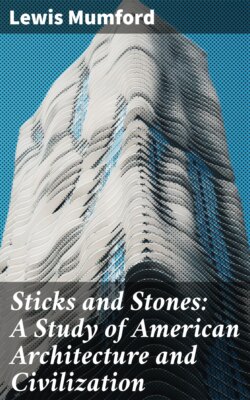Читать книгу Sticks and Stones: A Study of American Architecture and Civilization - Lewis Mumford - Страница 11
На сайте Литреса книга снята с продажи.
III
ОглавлениеTable of Contents
The first effect of the Renaissance forms in America was not to destroy the vernacular but to perfect it; for it provided the carpenter-builder, whose distance from Europe kept him from profiting by the spirited work of his forbears, with a series of ornamental motifs. New England, under the influence of an idol-breaking Puritanism, had been singularly poor in decoration, as I have already observed: its modest architectural effects relied solely on mass, color, and a nice disposition of parts. In its decorative aspects medievalism had left but a trace in America: the carved grotesque heads on the face of the Van Cortlandt Mansion in New York, and the painted decorations in some of the older houses and barns among the Pennsylvania Dutch pretty well complete the tally.
Classical motifs served to fill the blank in provincial architecture. As long as the carpenter worked by himself, the classic influence was confined to little details like the fanlights, the moldings, the pillars of the portico, and so on. In the rural districts of New England, from Maine to Connecticut, and in certain parts of New York and New Jersey and Pennsylvania, the carpenter keeps on building in his solid, traditional manner down to the time that the jig-saw overwhelms a mechanically hypnotized age; and even through the jig-saw period in the older regions, the proportions and the plan remained close to tradition. The classical did not in fact supplant the vernacular until the last vestiges of the guild and the village-community had passed away, and the economic conditions appropriate to the Renaissance culture had made their appearance.
The dwelling house slowly became more habitable during this period: the skill in shipbuilding which every sheltered inlet gave evidence of was carried back into the home, and in the paneling of the walls and the general tidiness and compactness of the apartments, a shipshape order comes more and more to prevail. The plastered ceiling makes its appearance, and the papered wall; above all, white paint is introduced on the inside and outside of the house.
Besides giving more light, this innovation surely indicates that chimney flues had become more satisfactory. Paint was no doubt introduced to keep the torrid summer sun from charring the exposed clapboards; and white paint was used, despite the expense of white lead, for the reason that it accorded with the chaste effect which was inseparable in the eighteenth-century mind from classic precedent.
Indeed, the whiteness of our colonial architecture is an essential characteristic; it dazzled Dickens on his first visit to America, and made him think that all the houses had been built only yesterday. The esthetic reason for delighting in these white colonial farmhouses is simple: white and white alone fully reflects the surrounding lights; white and white alone gives a pure blue or lavender shadow against the sunlight. At dawn, a white house is pale pink and turquoise; at high noon it is clear yellow and lavender-blue; in a ripe sunset it is orange and purple; in short, except on a gray day it is anything but white. These old white houses, if they seem a little sudden and sharp in the landscape, are at least part of the sky: one finds them stretched on a slight rise above the highroad like a seagull with poised wings, or a cloud above the treetops. Were anything needed to make visible the deterioration of American life which the nineteenth century brought with it, the habit of painting both wood and brick gray should perhaps be sufficient.
